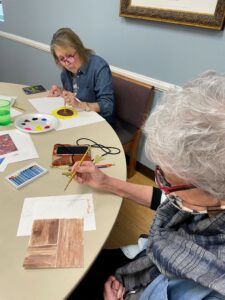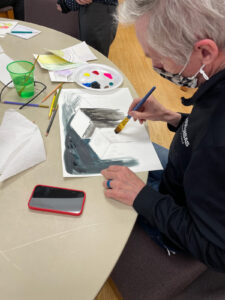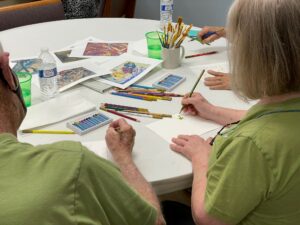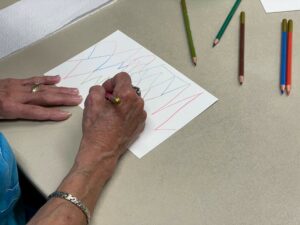View Larger Image

John Helmcamp, left, shows his artwork to Suzanne Dhall.
Art for Parkinson’s Workshops Provide Fun, Education, Social Interaction
| |As the music began, about 15 people sitting around large round tables picked up watercolor pencils and let the symphonic sounds guide their hands as they applied colorful streaks and patterns across plain white poster board.
Some made bold, jagged marks while others sculpted gentle curves. Some used dark colors; others, pastels or brights. They switched colors, styles, mediums and tools as the songs changed to create different moods.
Before trying their hands at abstract art, instructor Elly Bates of Arts Integration Services showed them a famous abstract painting that Wassily Kandinsky created in 1925 called “Yellow, Red, Blue.” They learned that the Russian painter often listened to composer Arnold Schoenberg’s music – which they soon began listening to — for inspiration while creating his masterpieces.
Put on by the University of Arkansas for Medical Sciences (UAMS) Movement Disorders Clinic in participation with Arts Integration Services, the March 29 class at St. Michael’s Episcopal Church in Little Rock was the first of five scheduled Art for Parkinson’s workshops through July, with more to follow. The classes are designed to introduce Parkinson’s patients to art, which research shows may help them improve motor skills, and which Parkinson’s patients say is relaxing and helps control their tremors.
The second session of this monthly class was held April 19 at St. Michael’s. A third session is scheduled for May 17 at the South Arkansas Arts Center in El Dorado, and the final two sessions for the first semester, on June 21 and July 19, will be at St. Michael’s again. Each session runs from 9:30 a.m. to noon and is free. Patients are encouraged to attend as many sessions as they’d like, and the caregivers accompanying them are welcome to participate. A virtual component is available for those who cannot participate in person.
Bates, a painter, showed the class five examples of well-known paintings that their creators said were inspired by music.
Then as she played different selections of music that the artists were known to use to inspire their art, she encouraged the participants to try a variety of tools and colors to create whatever came to mind. Before them lay watercolor pencils, which could be used dry or dipped in water, oil pastels and acrylic paint.
The theme of the first class was music and the theme of the second class will be light. Each of the five classes will have a different “muse,” Bates said.
From the beginning, she assured the group, “There’s no pressure. I’m not asking for any realism or anything like that.”
“I have faith you guys can do this,” added Suzanne Dhall, Dr.PH., MSPH, CHES, a health educator in the UAMS Department of Neurology. “Let’s have fun!”
Dhall, who organized the workshops, said she hopes to eventually offer classes incorporating “an intergenerational component, where children and Parkinson’s patients work together. I think we have a lot to learn from each other.”
Bates told the class that Marc Chagall, an early modernist painter, was known to listen to “The Magic Flute,” an opera by Wolfgang Amadeus Mozart, on repeat in his studio while creating many of his famous pieces.
John Helmcamp of Little Rock, a Parkinson’s patient who for 10 or 12 years has been making and selling pressed-flower art using frames found in estate sales, said he enjoyed trying out a different form of art — drawing and painting — in the workshop. He began a piece with watercolor pencils while listening to “The Magic Flute.” He added layers as the music selections changed, and dubbed the finished product “the Phoenix.”
The former registered nurse of 29 years, who was also a ballroom dance instructor, said he doesn’t let Parkinson’s stop him from creating his pressed flower artwork, but “some days, my left hand just says no, not today.” He is right-handed and uses his right hand to arrange the flowers, while his left hand is used as a stabilizer even though it is subject to tremors.
“Sometimes the focus helps direct me away from the tremors,” Helmcamp said.
Kay Waldo, another participant who has had Parkinson’s since 2012 and retired in 2020 as director of administrative services for the Arkansas Medical Society, attended the workshop with her caregiver.
“I’m just looking for things I can do and have fun,” she said. Her finished painting featured a big yellow sunflower encircled by bright green vines.
Frank O’Mara, a former athlete who ran track for the University of Arkansas in Fayetteville and was diagnosed with Parkinson’s in 2009, said he attended the workshop at the suggestion of Rohit Dhall, M.D., a professor of neurology and director of neurodegenerative disorders at UAMS. O’Mara, who was trained in civil engineering, impressed his classmates with a painting consisting of rectangles that came to represent a cityscape.
“Are you an architect?” someone asked.
Bobbie Verser, a Parkinson’s patient since 2016 who taught school for 20 years and then spent 12 years working as an administrator for a state circuit judge, said she saw information about the workshop in a waiting room at UAMS, and went as a way to meet people.
“It’s good for meeting people and this works on your motor skills,” she said. “I do handwriting exercises at home.”
Verser used various shades of brown to create an array of rectangles that resembled a section of wood-grain flooring.
“Things like this we adore,” said Nancy Hurlburt, who was participating as a caregiver for her husband of 48 years who was diagnosed with Parkinson’s in 2011. “We are happy, happy, happy to try this.”
Preston Hurlburt proudly displayed his painting, which consisted mostly of shades of dark green. He said it had evolved into a birdbath after starting off as an alligator in a tree.
“It’s fun,” said Hurlburt, who once worked in industrial construction.
By the end of the morning, the finished products also included abstract intersections of straight and fuzzy lines in a dizzying array of colors and a serene landscape beneath a rising or setting sun.
The participants were invited to leave their finished work to be included in art show of work from all five workshops from the first semester.
For more information or to register for an upcoming class, visit bit.ly/PDArt1 or contact Suzanne Dhall by email at sjdhall@uams.edu or by calling or texting her at 602-635-0739.



